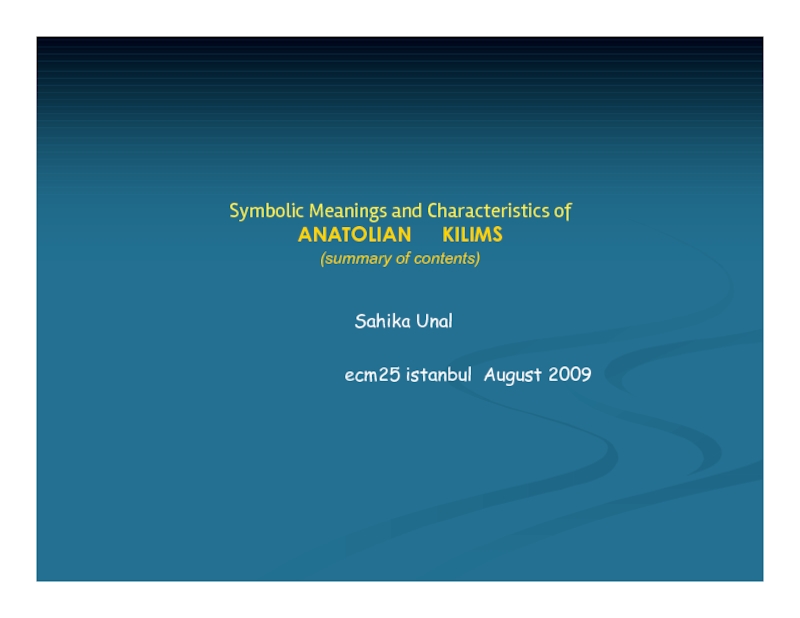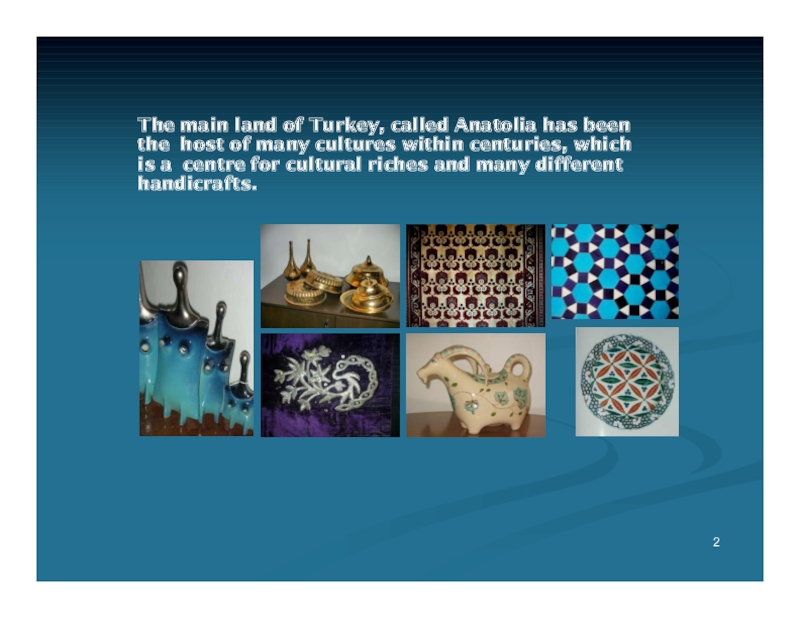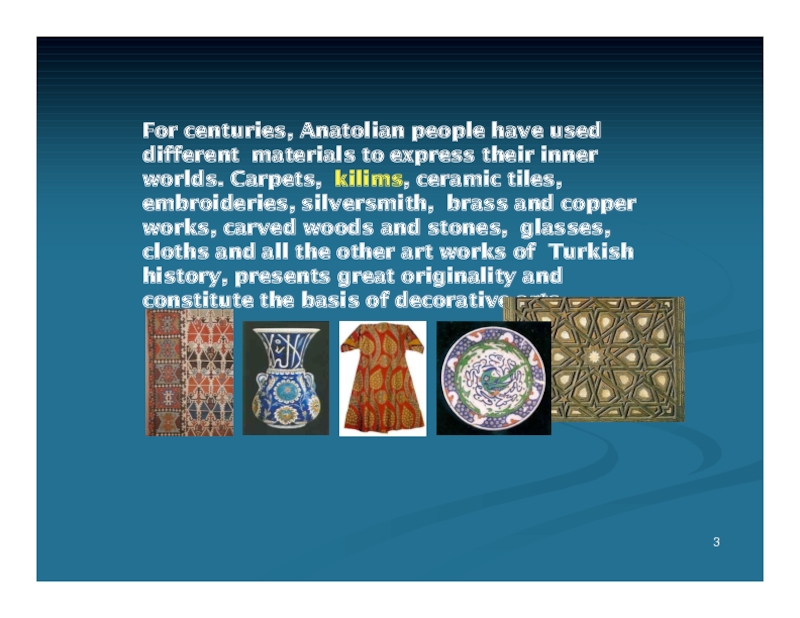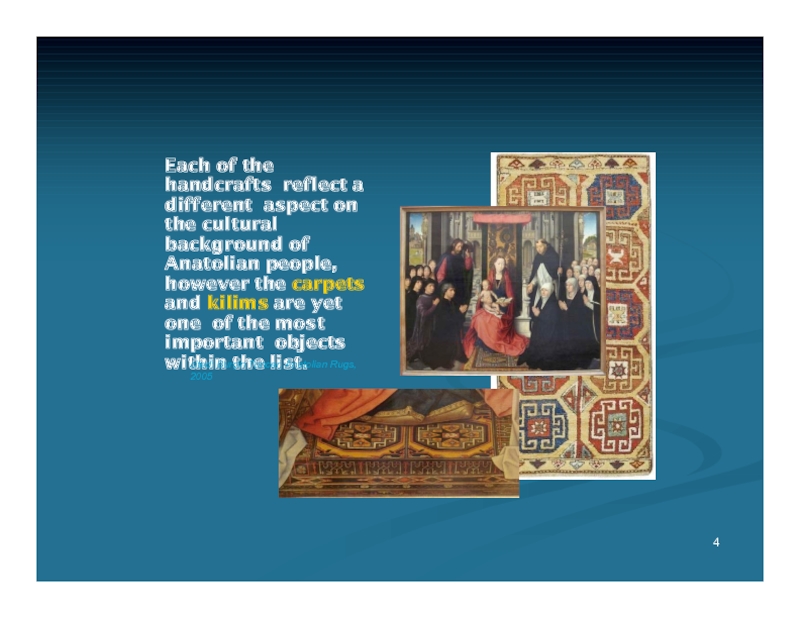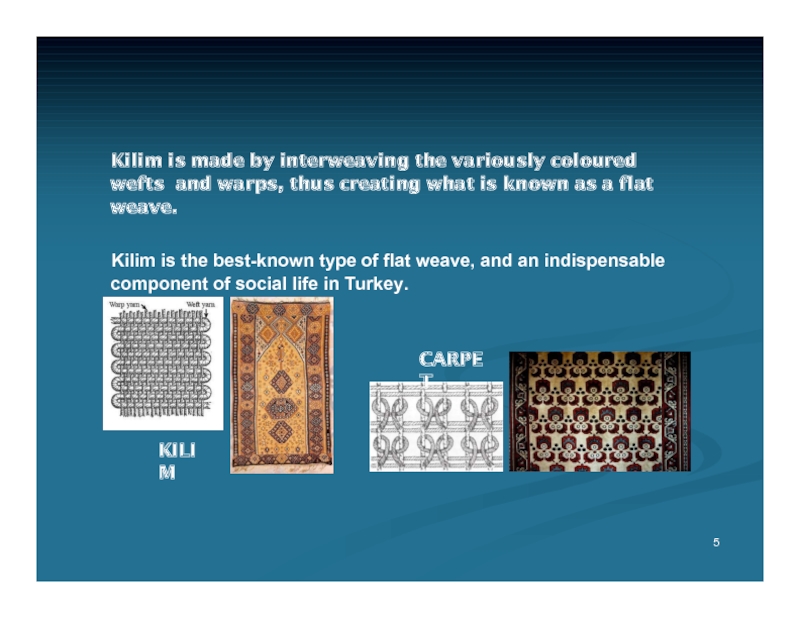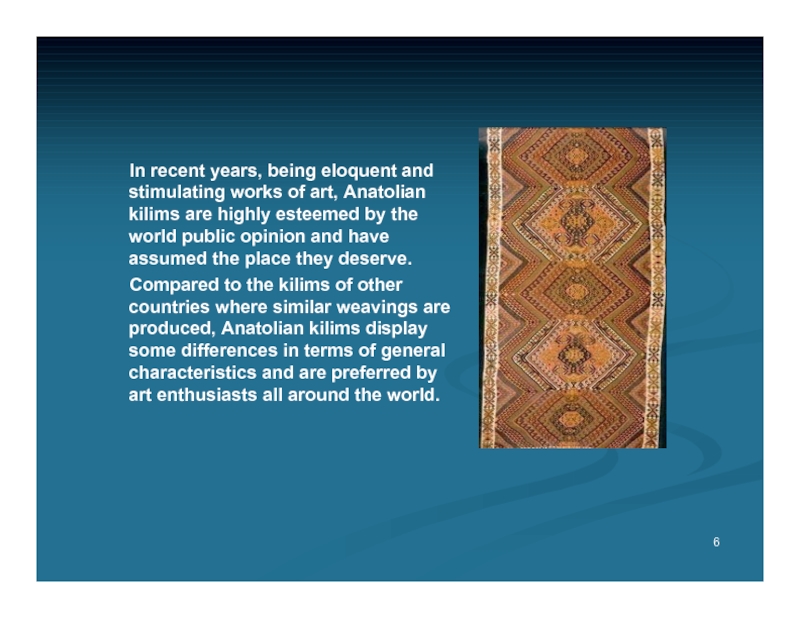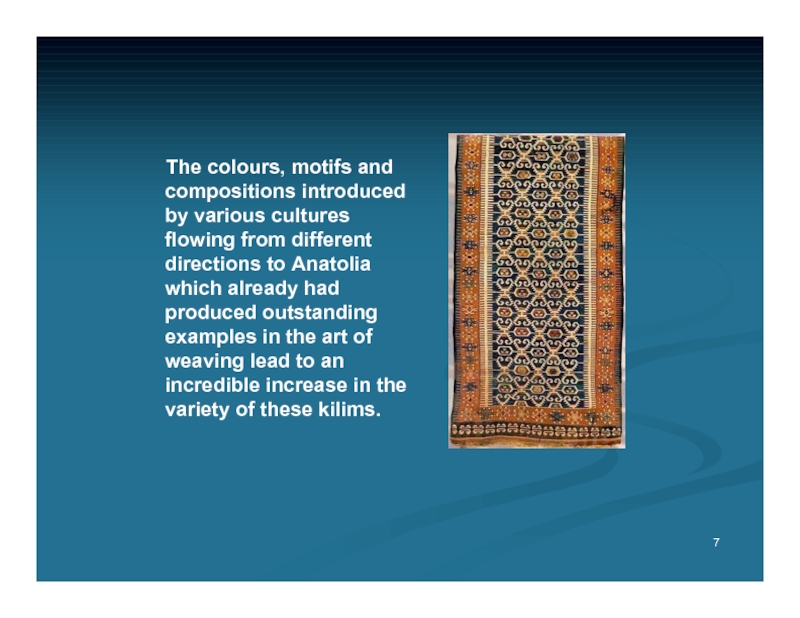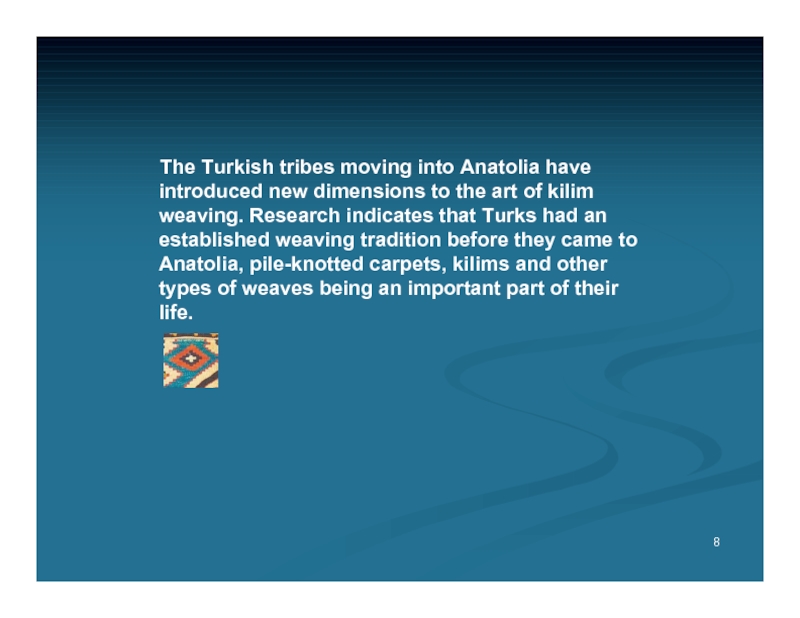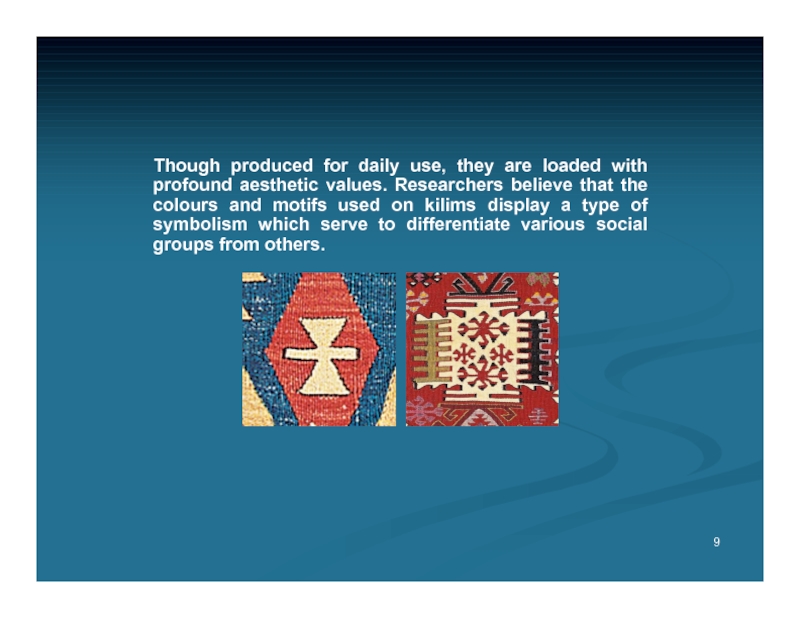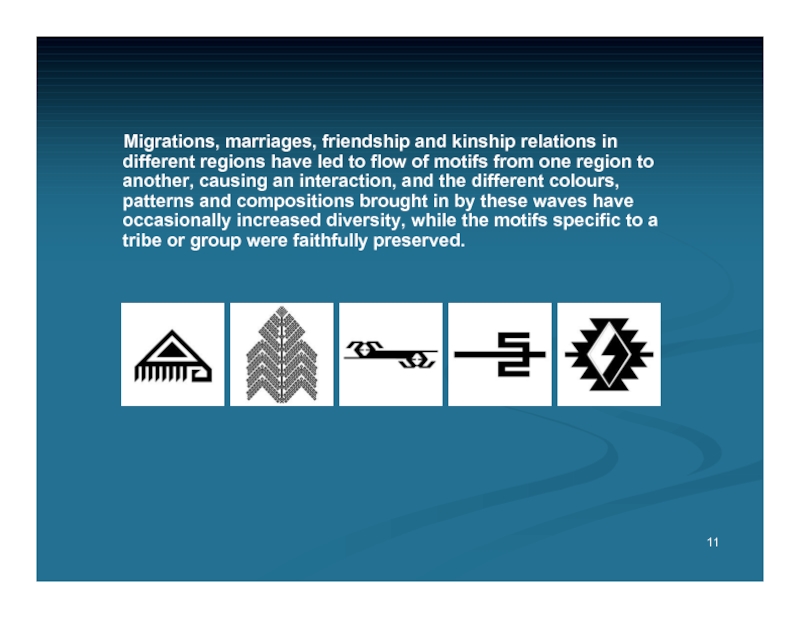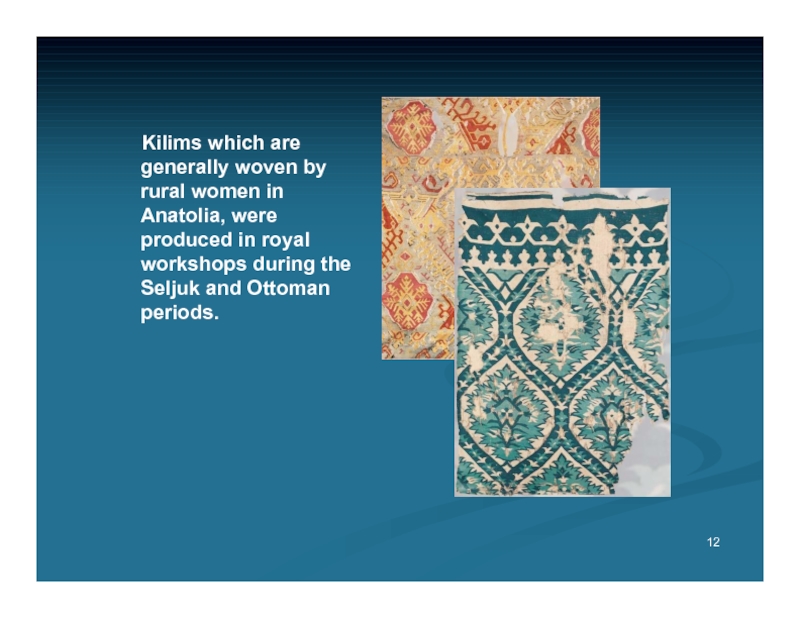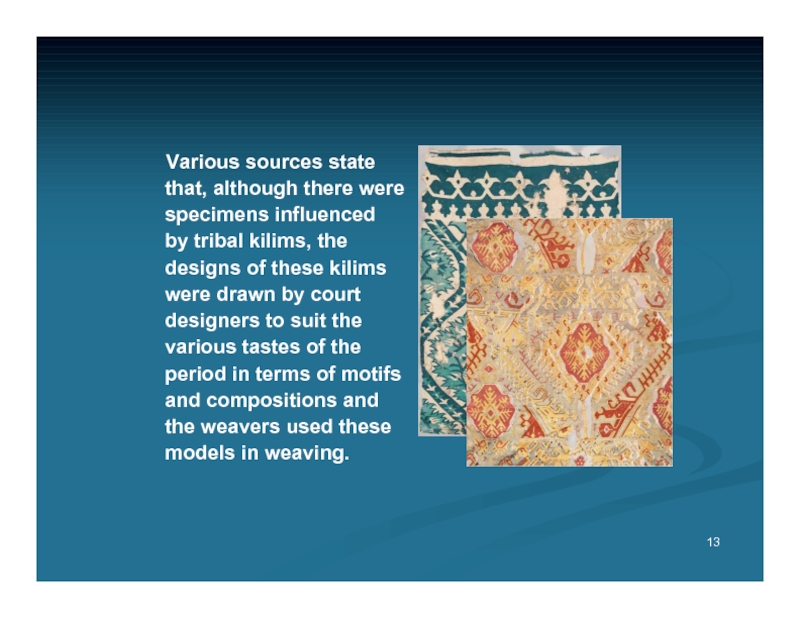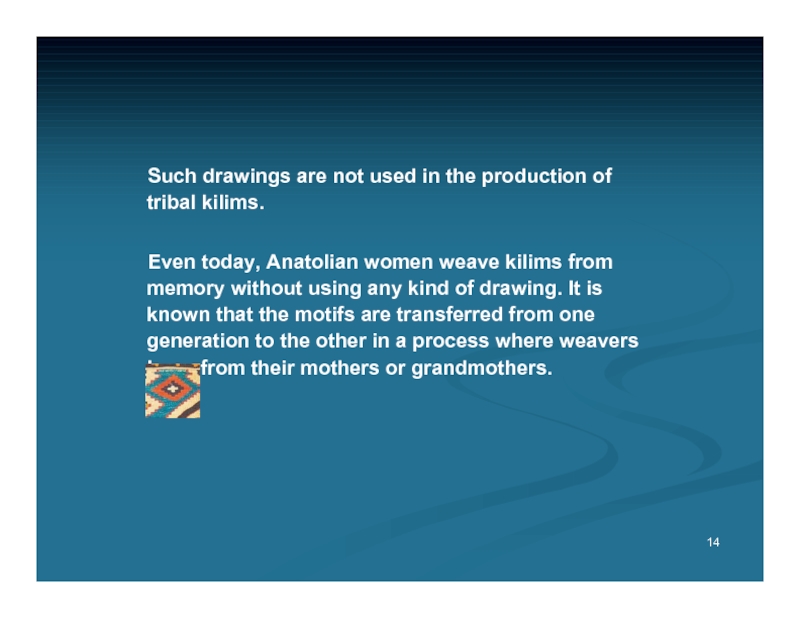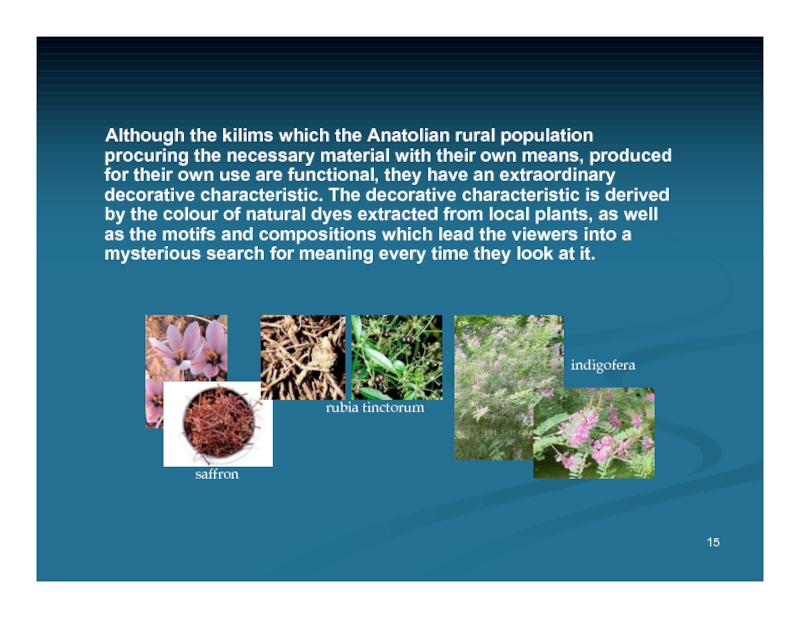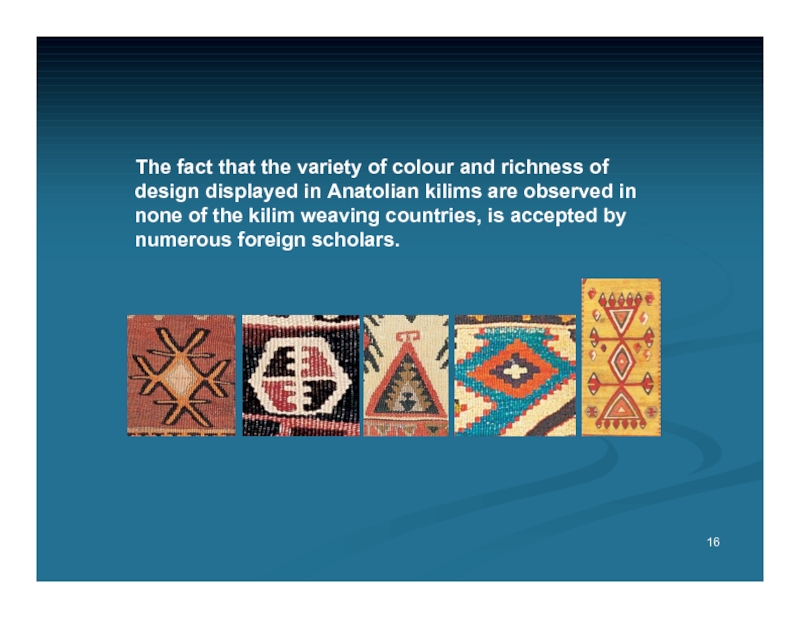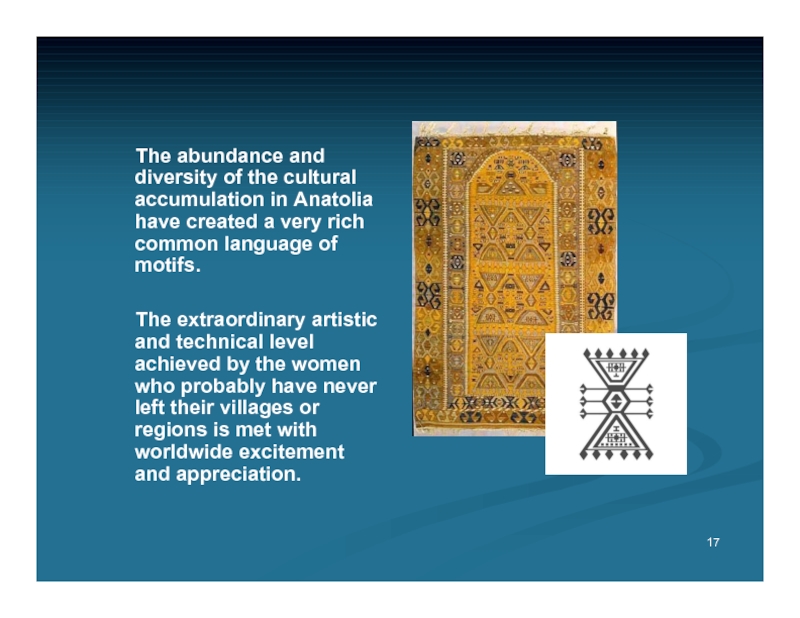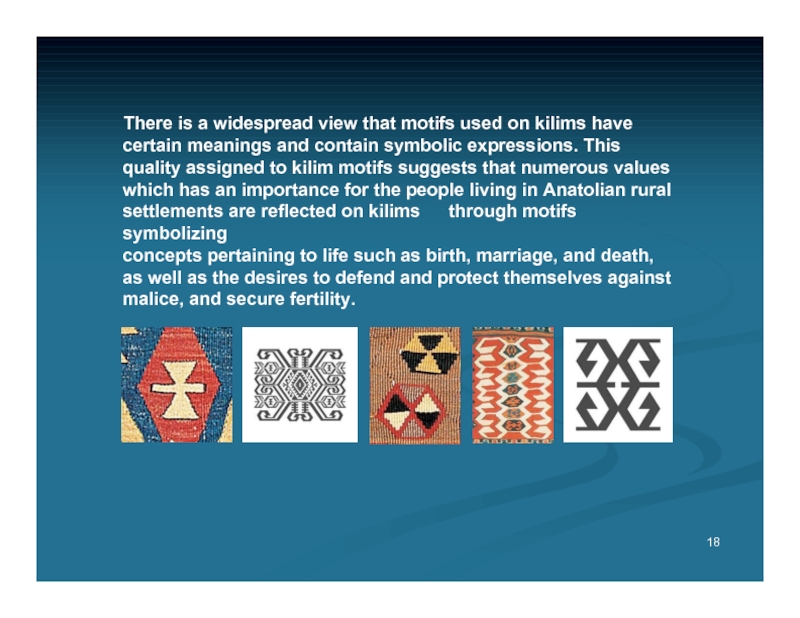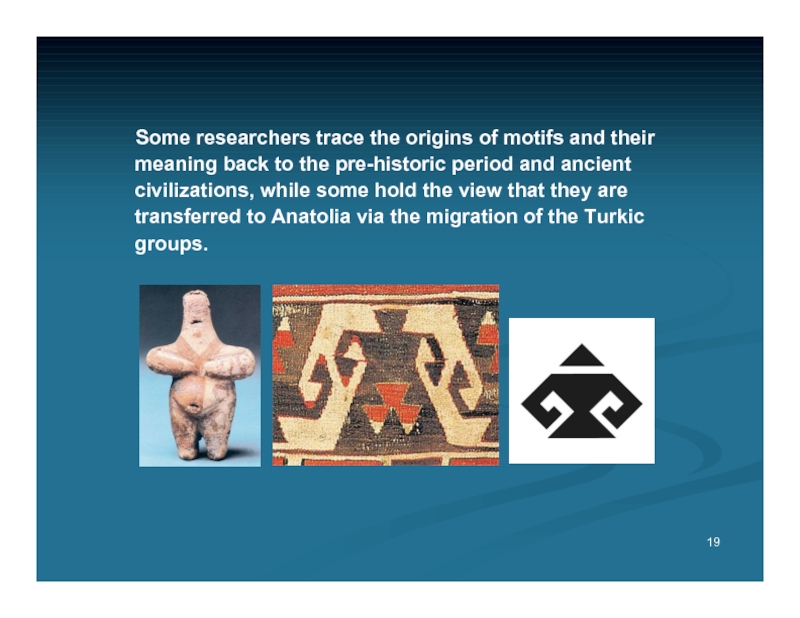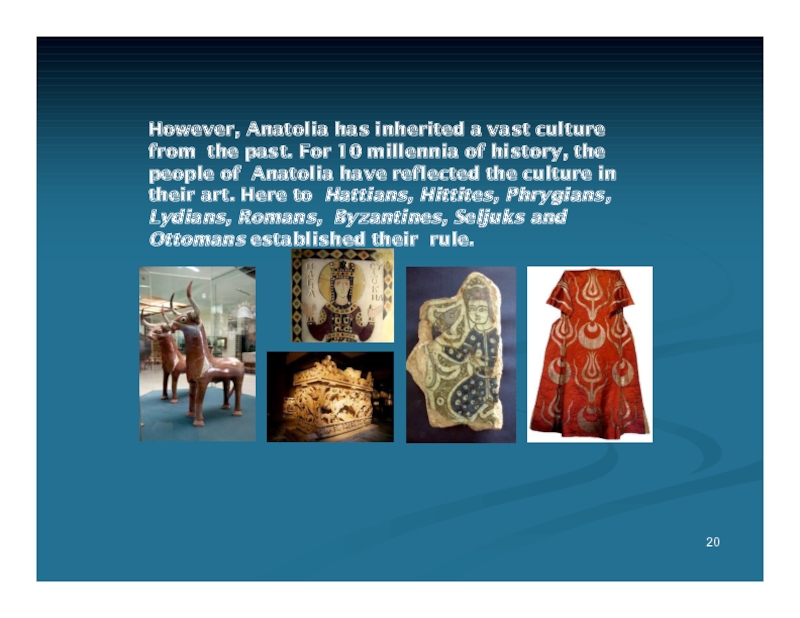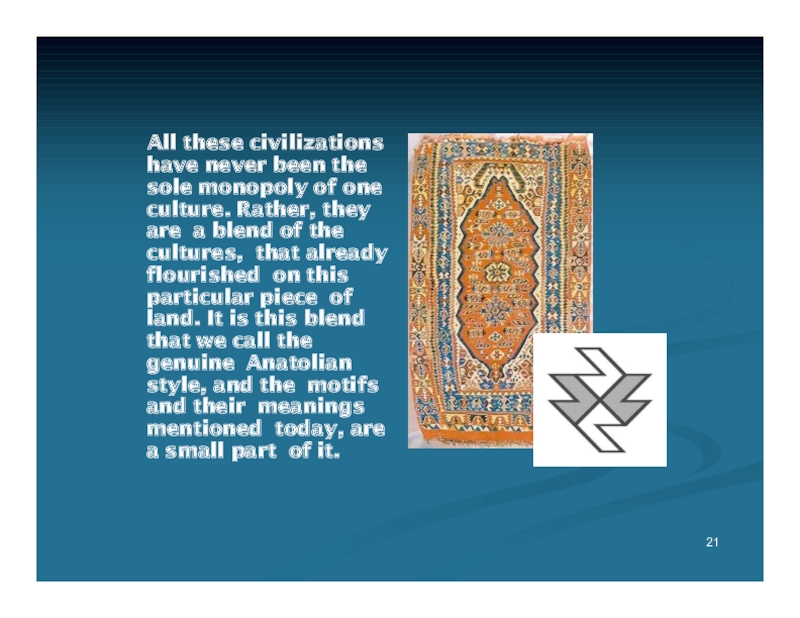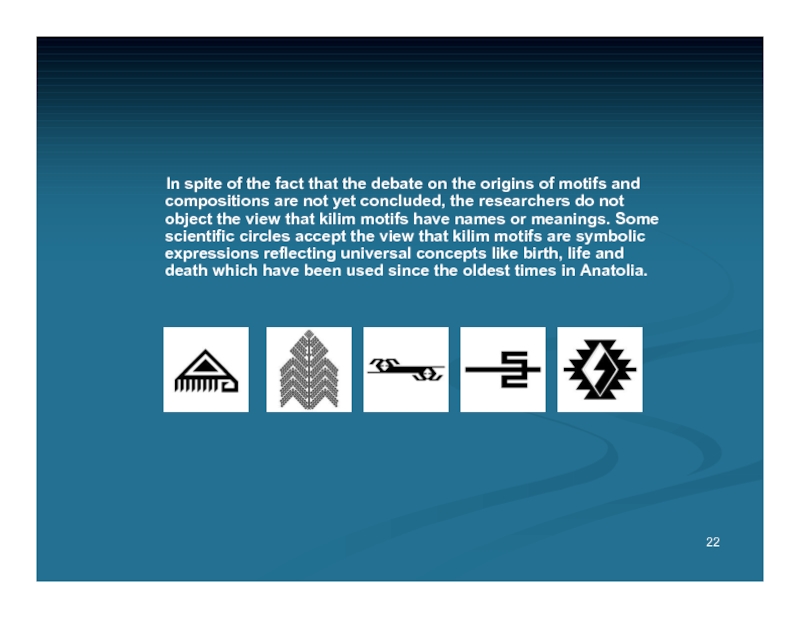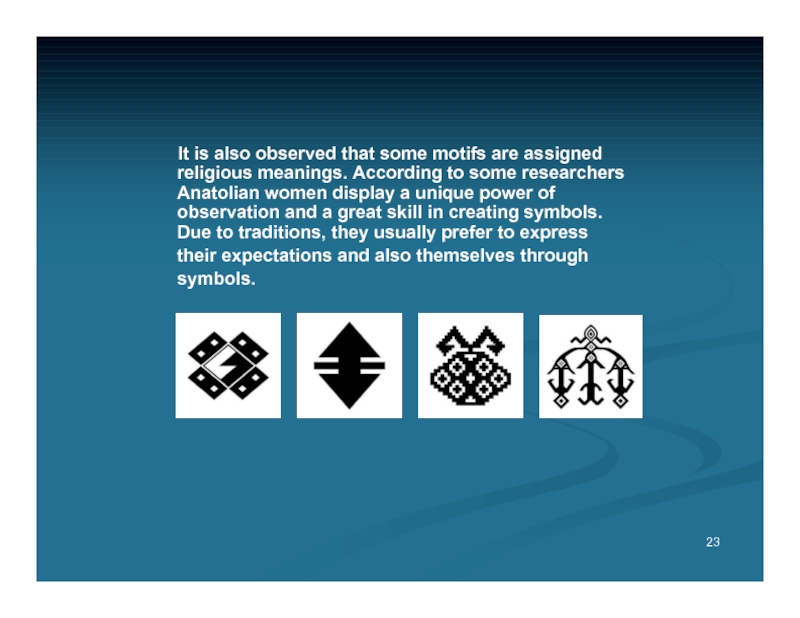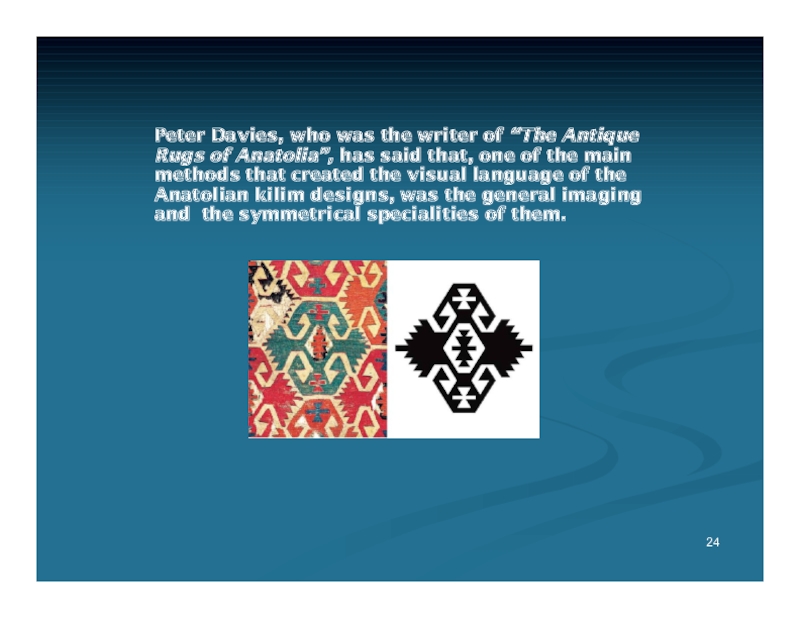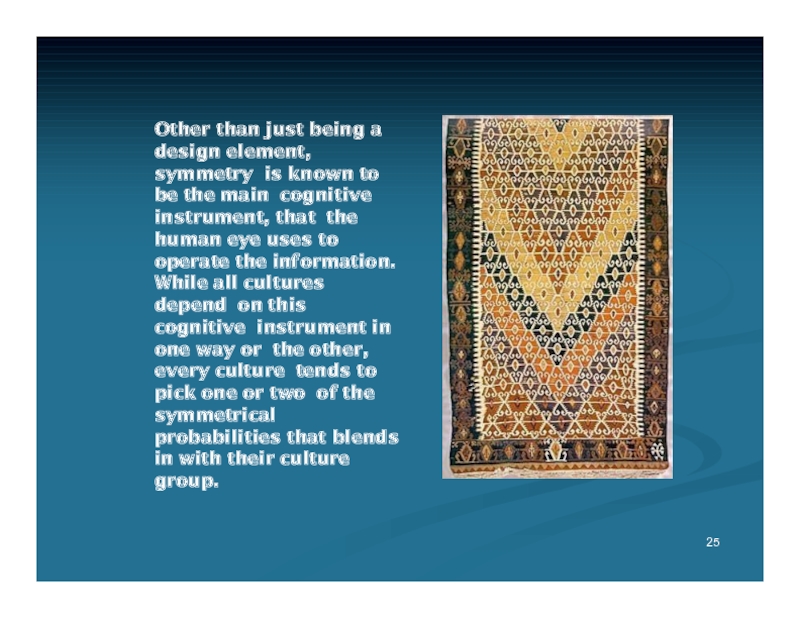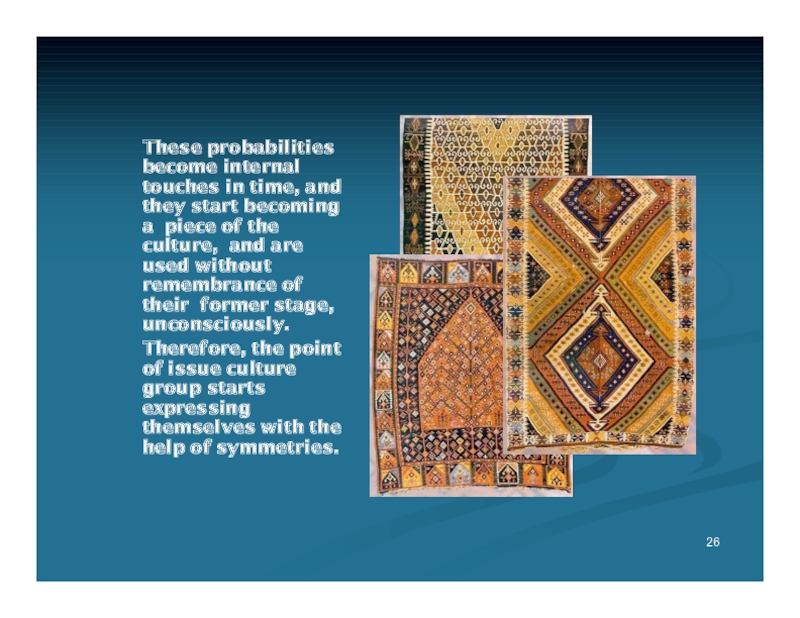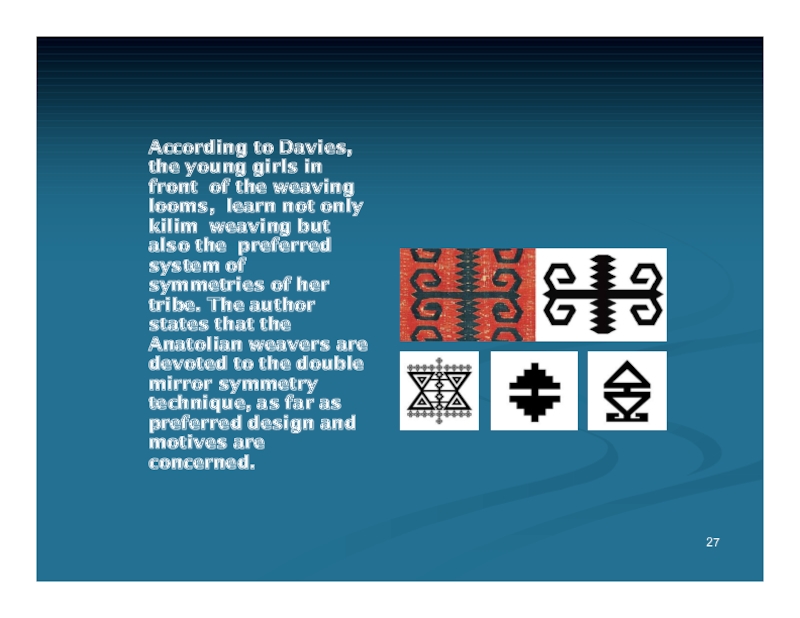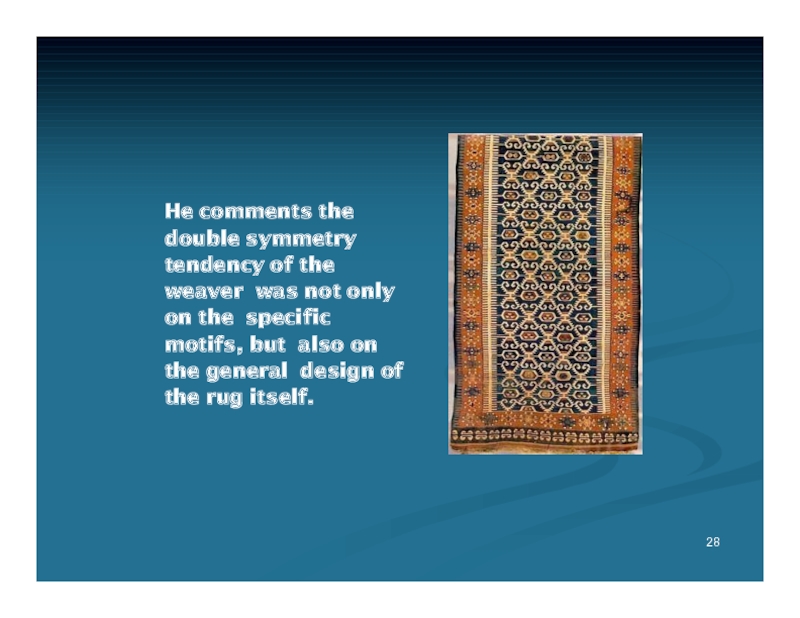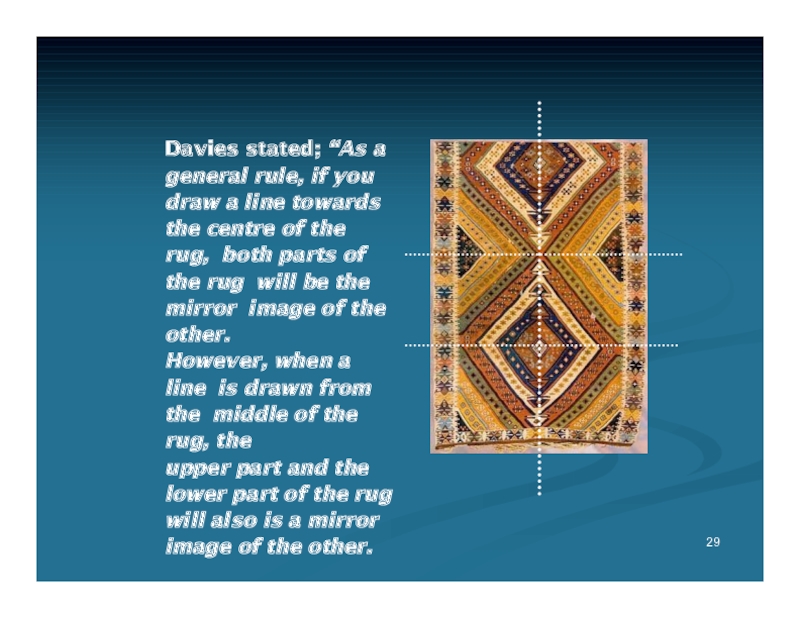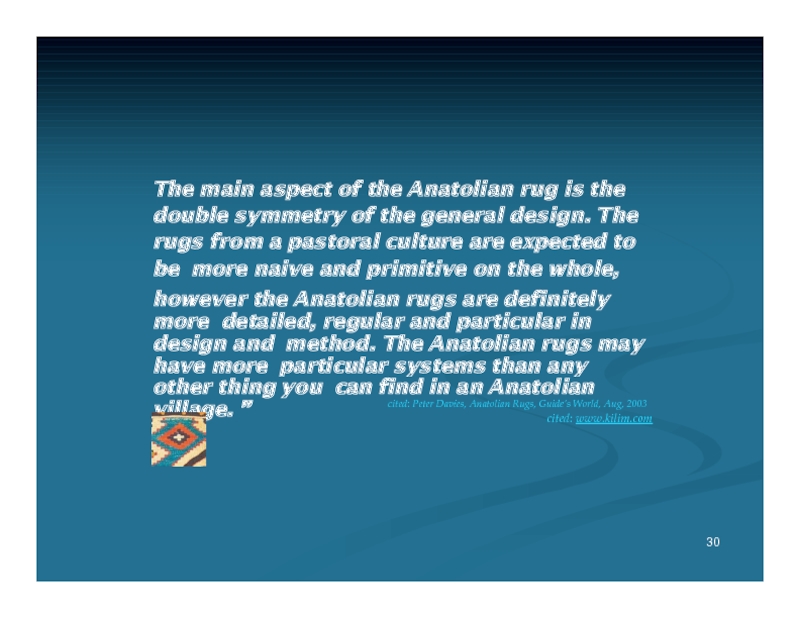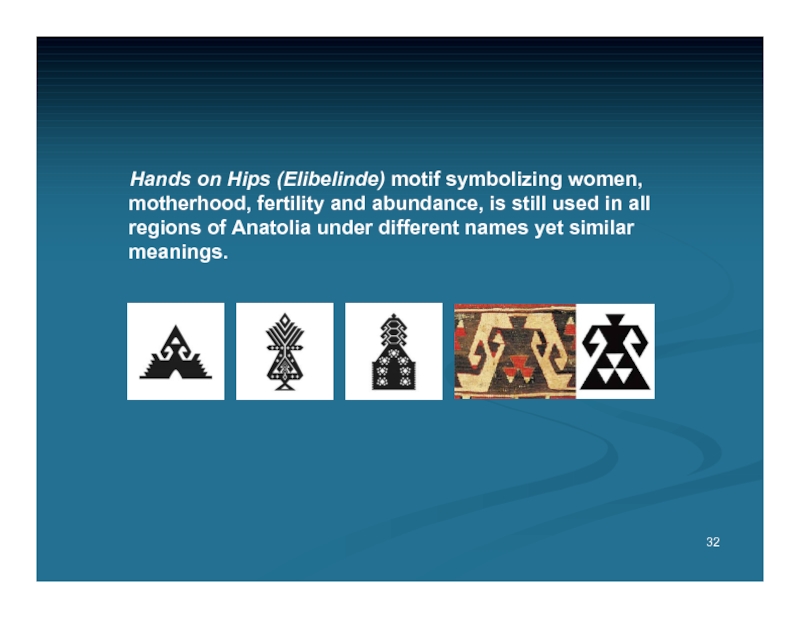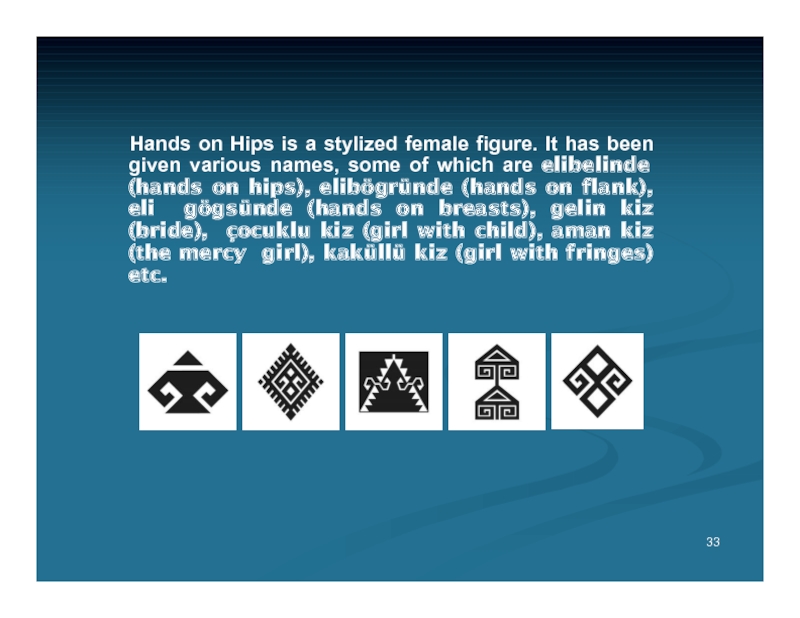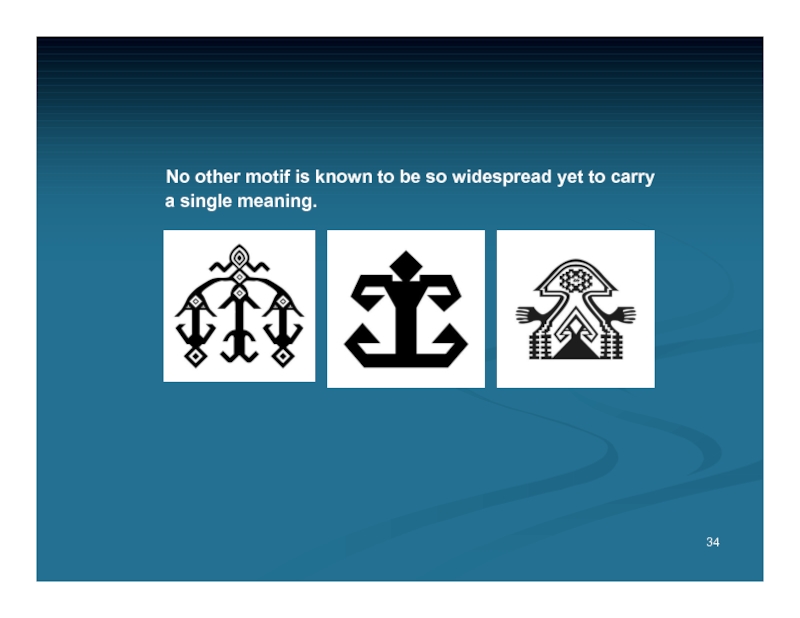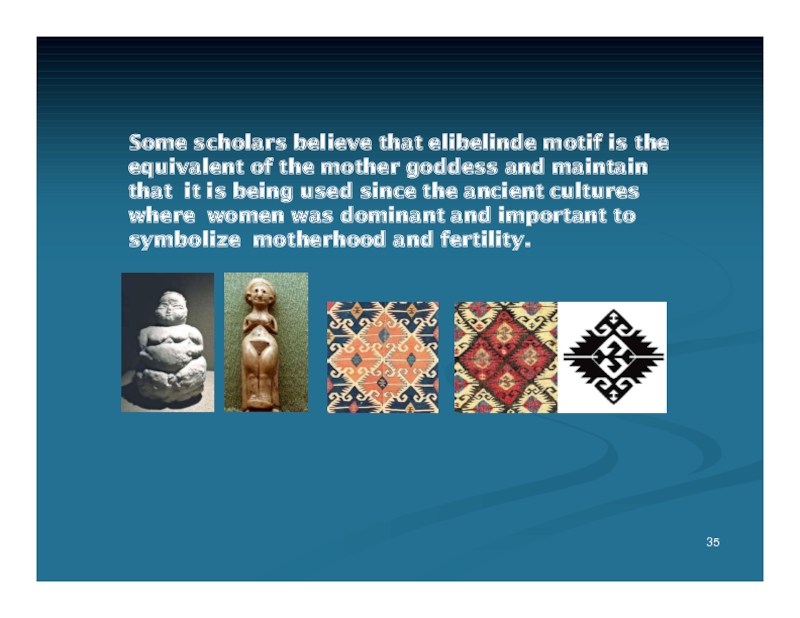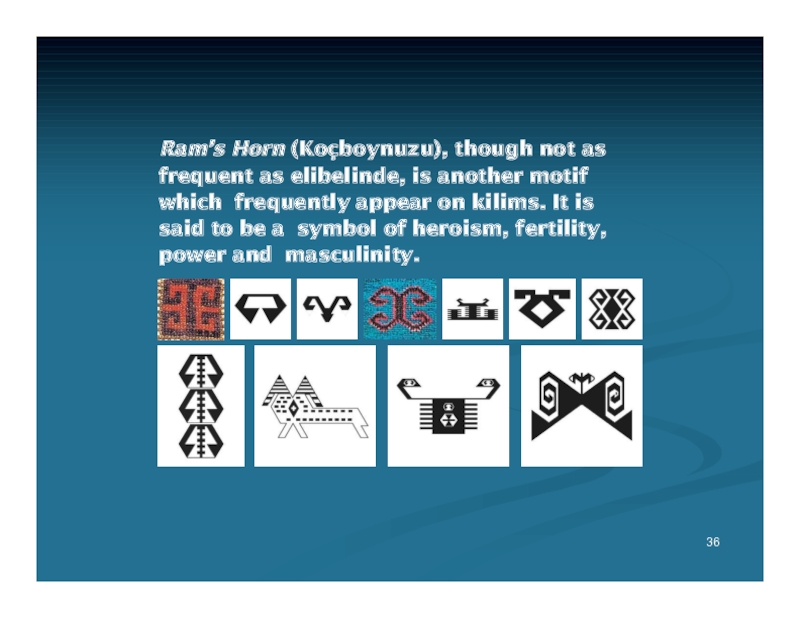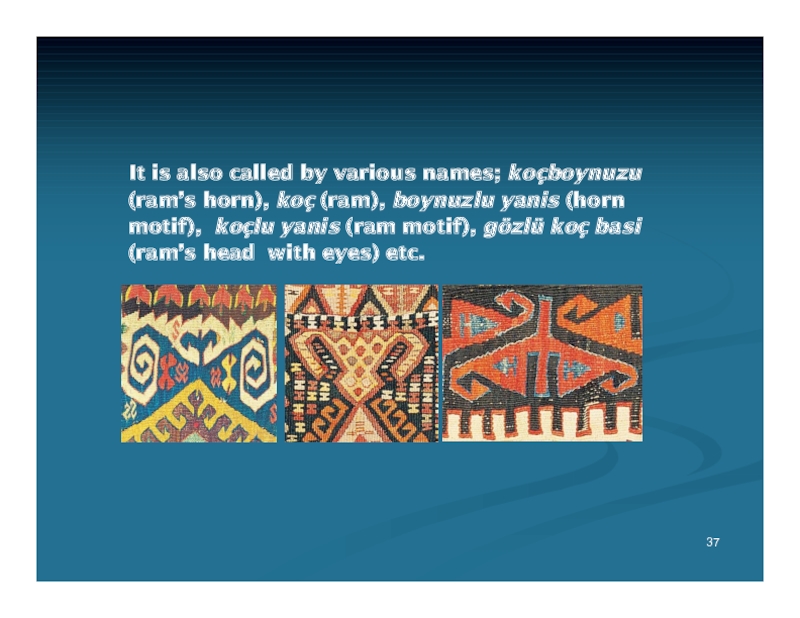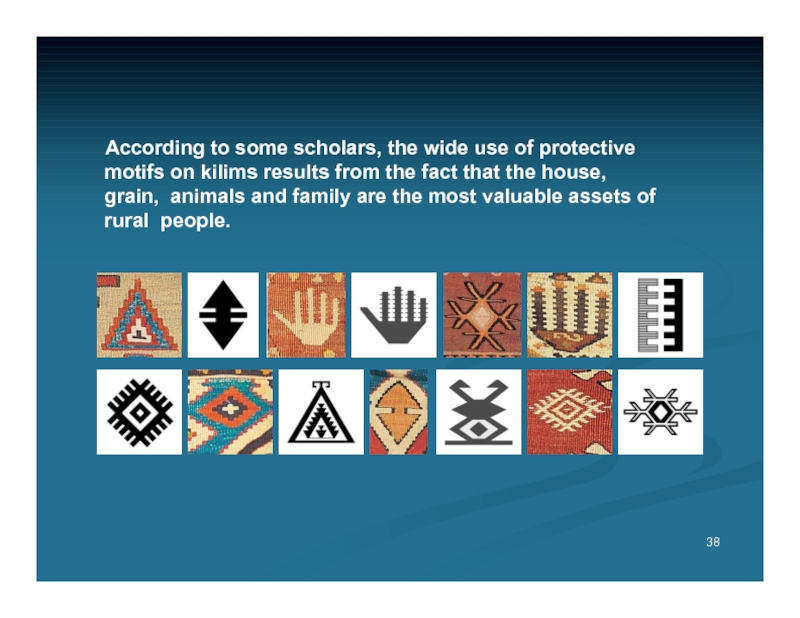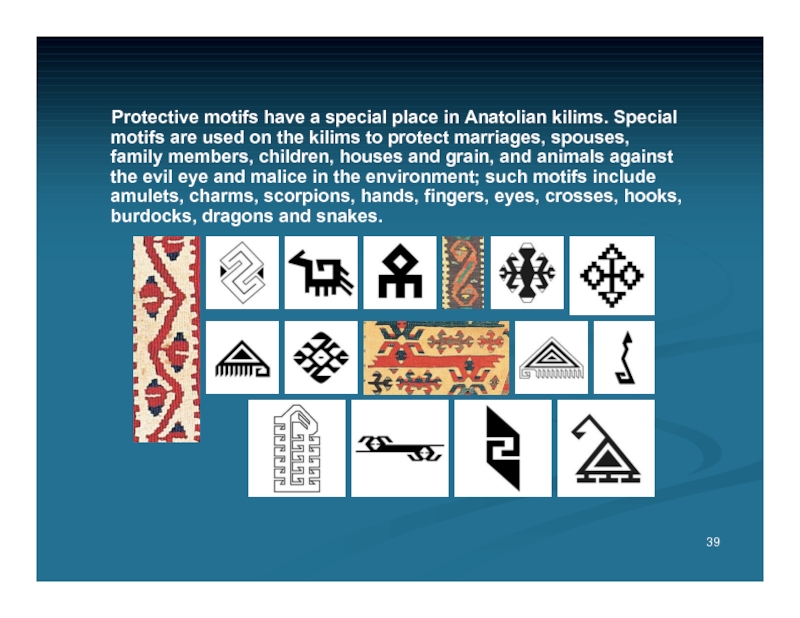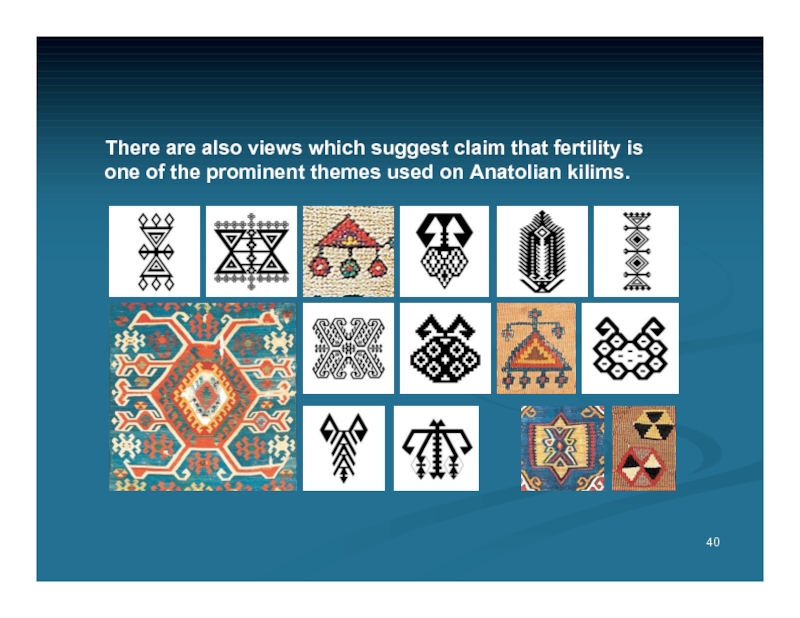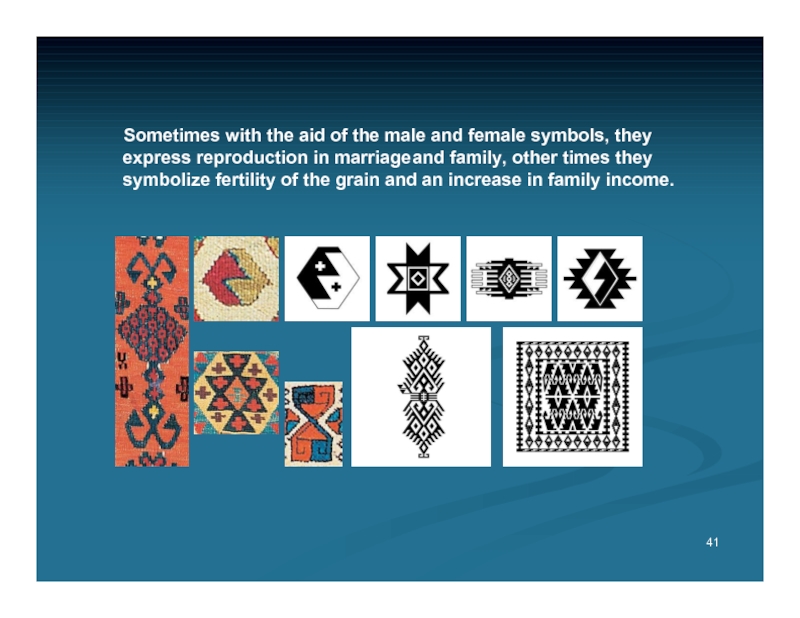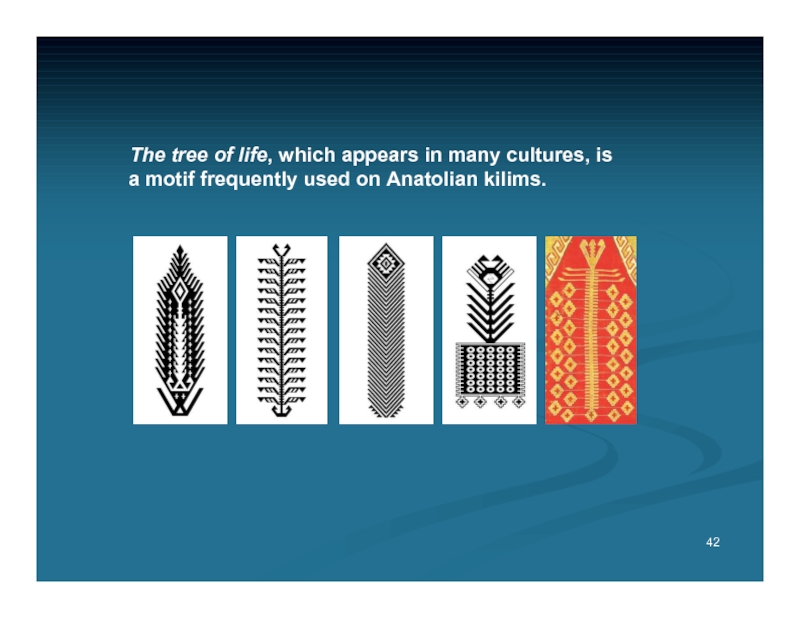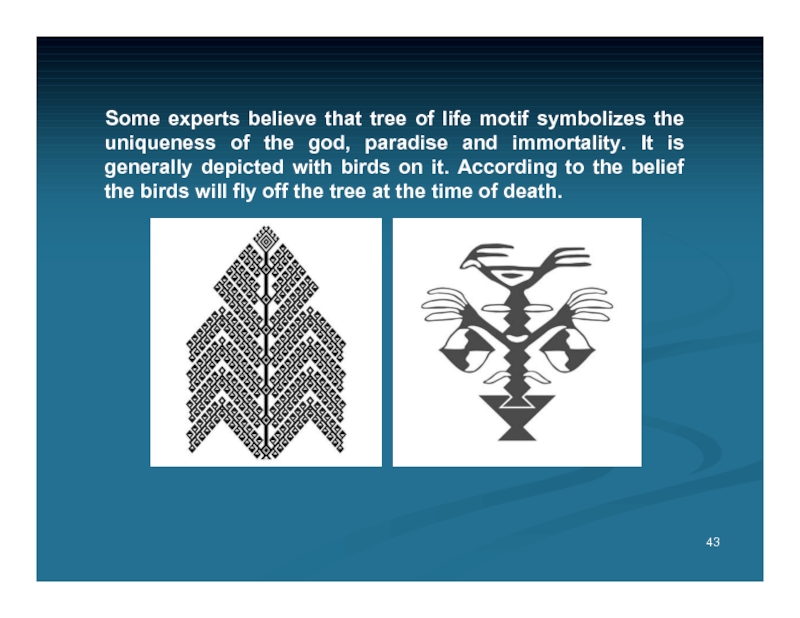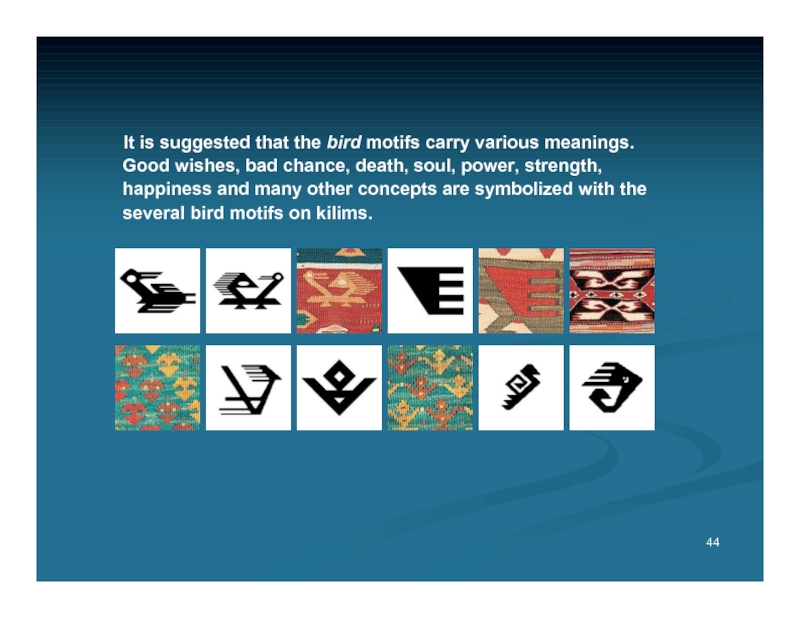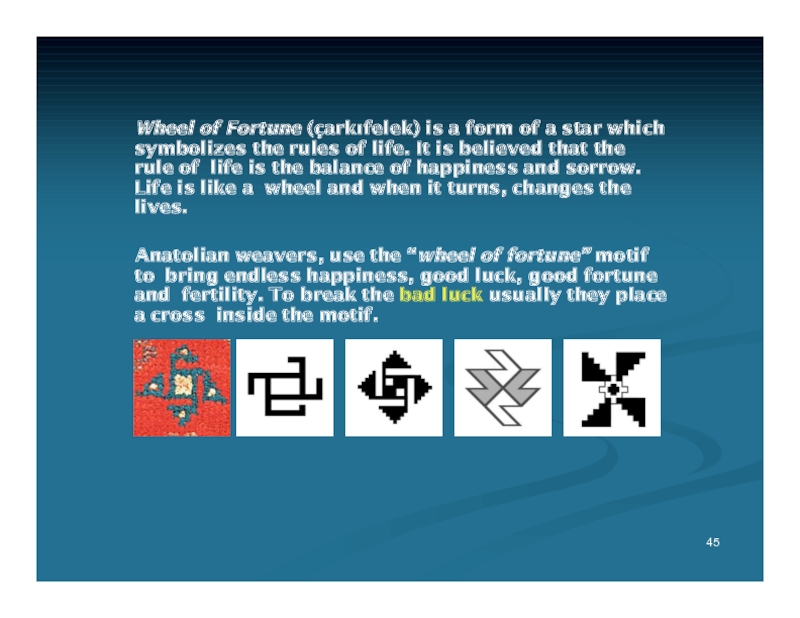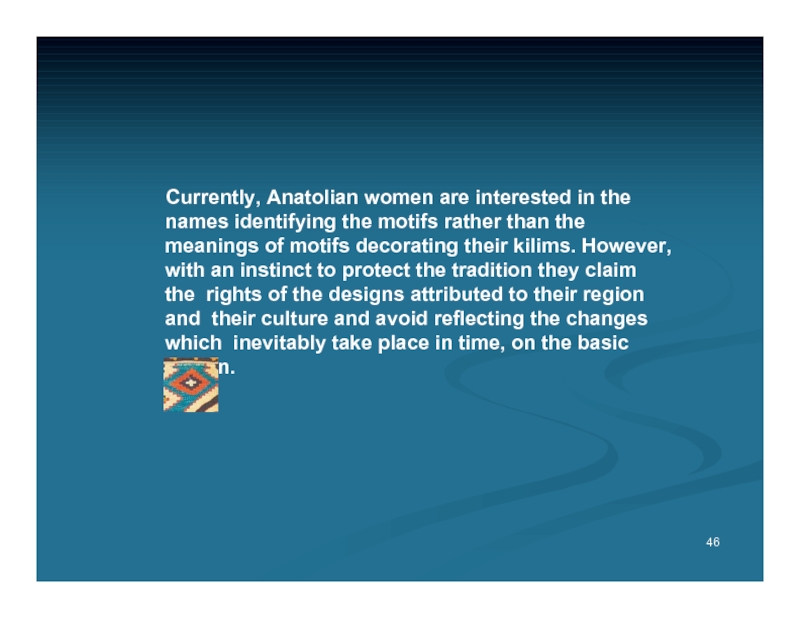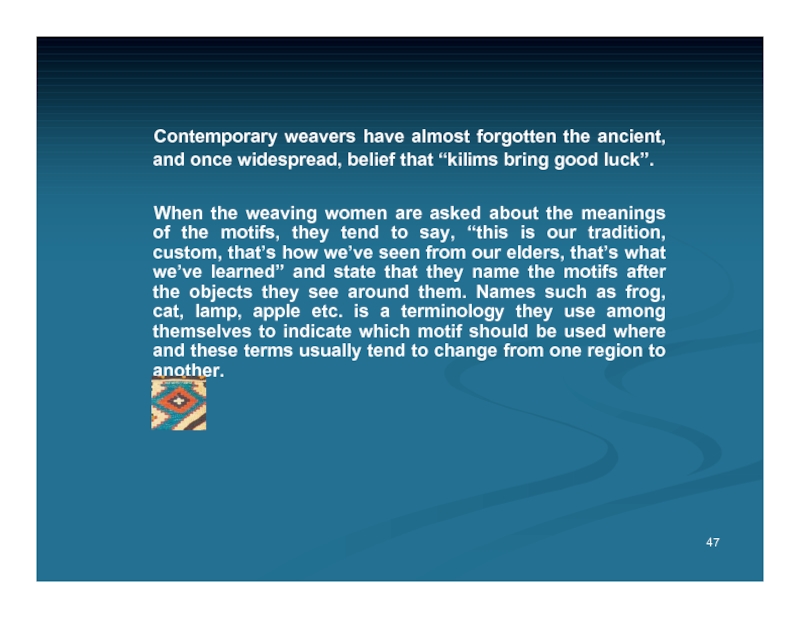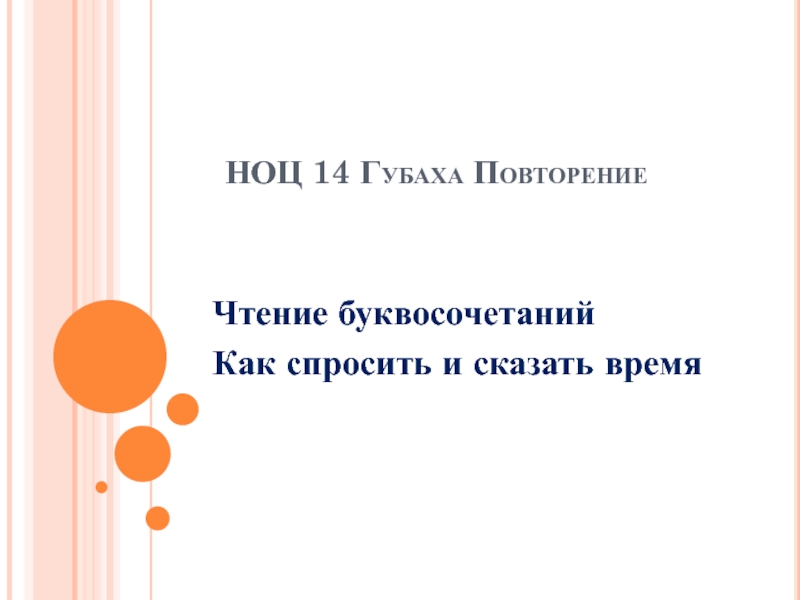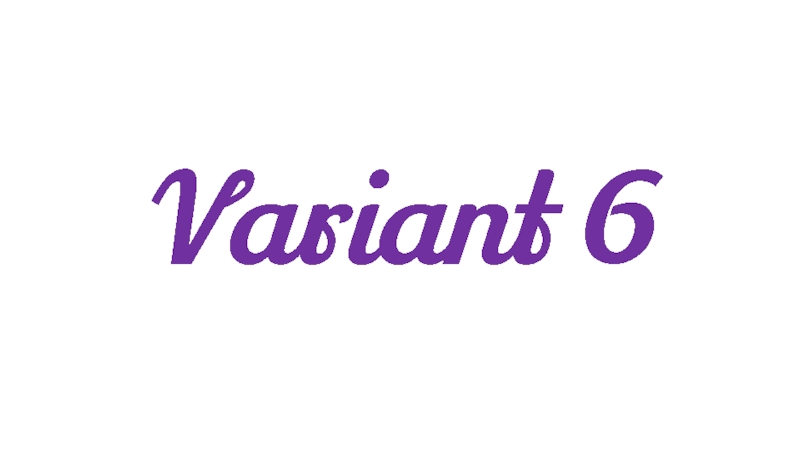- Главная
- Разное
- Дизайн
- Бизнес и предпринимательство
- Аналитика
- Образование
- Развлечения
- Красота и здоровье
- Финансы
- Государство
- Путешествия
- Спорт
- Недвижимость
- Армия
- Графика
- Культурология
- Еда и кулинария
- Лингвистика
- Английский язык
- Астрономия
- Алгебра
- Биология
- География
- Детские презентации
- Информатика
- История
- Литература
- Маркетинг
- Математика
- Медицина
- Менеджмент
- Музыка
- МХК
- Немецкий язык
- ОБЖ
- Обществознание
- Окружающий мир
- Педагогика
- Русский язык
- Технология
- Физика
- Философия
- Химия
- Шаблоны, картинки для презентаций
- Экология
- Экономика
- Юриспруденция
Symbolic meanings and characteristics of anatolian kilims презентация
Содержание
Слайд 1
Symbolic Meanings and Characteristics of ANATOLIAN KILIMS
(summary of contents)
Sahika Unal
ecm25 istanbul August
Слайд 2
The main land of Turkey, called Anatolia has been the host
Слайд 3
For centuries, Anatolian people have used different materials to express their
Слайд 4
Each of the handcrafts reflect a different aspect on the cultural
cited: Burçin Tuncer, Anatolian Rugs, 2005
Слайд 5
Kilim is made by interweaving the variously coloured wefts and warps,
Kilim is the best-known type of flat weave, and an indispensable component of social life in Turkey.
CARPET
KILIM
Слайд 6
In recent years, being eloquent and stimulating works of art, Anatolian
world public opinion and have assumed the place they deserve.
Compared to the kilims of other countries where similar weavings are produced, Anatolian kilims display some differences in terms of general characteristics and are preferred by art enthusiasts all around the world.
Слайд 7
The colours, motifs and compositions introduced by various cultures flowing from
Слайд 8
The Turkish tribes moving into Anatolia have introduced new dimensions to
Слайд 9
Though produced for daily use, they are loaded with profound aesthetic
Слайд 10
Some experts suggest that these motifs were transported to Anatolia, through
10
Слайд 11
Migrations, marriages, friendship and kinship relations in different regions have led
Слайд 12
Kilims which are generally woven by rural women in Anatolia, were
Слайд 13
Various sources state that, although there were specimens influenced
by tribal kilims,
were drawn by court designers to suit the various tastes of the period in terms of motifs and compositions and the weavers used these models in weaving.
Слайд 14
Such drawings are not used in the production of tribal kilims.
Even
Слайд 15
Although the kilims which the Anatolian rural population procuring the necessary
saffron
indigofera
rubia tinctorum
Слайд 16
The fact that the variety of colour and richness of design
Слайд 17
The abundance and diversity of the cultural accumulation in Anatolia have
The extraordinary artistic and technical level achieved by the women who probably have never left their villages or regions is met with worldwide excitement and appreciation.
Слайд 18
There is a widespread view that motifs used on kilims have
concepts pertaining to life such as birth, marriage, and death, as well as the desires to defend and protect themselves against malice, and secure fertility.
Слайд 19
Some researchers trace the origins of motifs and their meaning back
Слайд 20
However, Anatolia has inherited a vast culture from the past. For
20
Слайд 21
All these civilizations have never been the sole monopoly of one
Слайд 22
In spite of the fact that the debate on the origins
Слайд 23
It is also observed that some motifs are assigned religious meanings.
Due to traditions, they usually prefer to express their expectations and also themselves through
symbols.
Слайд 24
Peter Davies, who was the writer of “The Antique Rugs of
Слайд 25
Other than just being a design element, symmetry is known to
operate the information. While all cultures depend on this cognitive instrument in one way or the other, every culture tends to pick one or two of the symmetrical probabilities that blends in with their culture group.
Слайд 26
These probabilities become internal touches in time, and they start becoming
Therefore, the point of issue culture group starts expressing themselves with the help of symmetries.
Слайд 27
According to Davies, the young girls in front of the weaving
Слайд 28
He comments the double symmetry tendency of the weaver was not
Слайд 29
Davies stated; “As a general rule, if you draw a line
However, when a line is drawn from the middle of the rug, the
upper part and the lower part of the rug will also is a mirror image of the other.
Слайд 30
The main aspect of the Anatolian rug is the double symmetry
however the Anatolian rugs are definitely more detailed, regular and particular in design and method. The Anatolian rugs may have more particular systems than any other thing you can find in an Anatolian village. ”
cited: Peter Davies, Anatolian Rugs, Guide’s World, Aug, 2003
cited: www.kilim.com
30
Слайд 31
There may be a reason of the symmetric choice of the
In Anatolia, the designs were woven from the weavers’ memory, rather than an outlined instruction sheet.
If we take a look at a kilim, we can see the capacity needed to memorize the design. Yet if one part of the whole image is memorized, the whole design could be re-created via mirror imaging, therefore makes it easier for the weaver to re-do the same kilim once again.
cited: www.kilim.com
Слайд 32
Hands on Hips (Elibelinde) motif symbolizing women, motherhood, fertility and abundance,
Слайд 33
Hands on Hips is a stylized female figure. It has been
Слайд 35
Some scholars believe that elibelinde motif is the equivalent of the
Слайд 36
Ram’s Horn (Koçboynuzu), though not as frequent as elibelinde, is another
Слайд 37
It is also called by various names; koçboynuzu (ram’s horn), koç
Слайд 38
According to some scholars, the wide use of protective motifs on
Слайд 39
Protective motifs have a special place in Anatolian kilims. Special motifs
Слайд 40
There are also views which suggest claim that fertility is one
40
Слайд 41
Sometimes with the aid of the male and female symbols, they
Слайд 42
The tree of life, which appears in many cultures, is a
Слайд 43
Some experts believe that tree of life motif symbolizes the uniqueness
Слайд 44
It is suggested that the bird motifs carry various meanings. Good
Слайд 45
Wheel of Fortune (çarkıfelek) is a form of a star which
Anatolian weavers, use the “wheel of fortune” motif to bring endless happiness, good luck, good fortune and fertility. To break the bad luck usually they place a cross inside the motif.
Слайд 46
Currently, Anatolian women are interested in the names identifying the motifs
Слайд 47
Contemporary weavers have almost forgotten the ancient, and once widespread, belief
When the weaving women are asked about the meanings of the motifs, they tend to say, “this is our tradition, custom, that’s how we’ve seen from our elders, that’s what we’ve learned” and state that they name the motifs after the objects they see around them. Names such as frog, cat, lamp, apple etc. is a terminology they use among themselves to indicate which motif should be used where and these terms usually tend to change from one region to another.
